+ Open data
Open data
- Basic information
Basic information
| Entry | Database: PDB / ID: 6k42 | |||||||||||||||||||||||||||||||||
|---|---|---|---|---|---|---|---|---|---|---|---|---|---|---|---|---|---|---|---|---|---|---|---|---|---|---|---|---|---|---|---|---|---|---|
| Title | cryo-EM structure of alpha2BAR-Gi1 complex | |||||||||||||||||||||||||||||||||
 Components Components |
| |||||||||||||||||||||||||||||||||
 Keywords Keywords | MEMBRANE PROTEIN / GPCR / Complex / cryo-EM | |||||||||||||||||||||||||||||||||
| Function / homology |  Function and homology information Function and homology informationActivation of the phototransduction cascade / Olfactory Signaling Pathway / negative regulation of uterine smooth muscle contraction / G beta:gamma signalling through PLC beta / Presynaptic function of Kainate receptors / adenylate cyclase-inhibiting adrenergic receptor signaling pathway / Prostacyclin signalling through prostacyclin receptor / alpha2-adrenergic receptor activity / Adrenaline signalling through Alpha-2 adrenergic receptor / Synthesis, secretion, and inactivation of Glucagon-like Peptide-1 (GLP-1) ...Activation of the phototransduction cascade / Olfactory Signaling Pathway / negative regulation of uterine smooth muscle contraction / G beta:gamma signalling through PLC beta / Presynaptic function of Kainate receptors / adenylate cyclase-inhibiting adrenergic receptor signaling pathway / Prostacyclin signalling through prostacyclin receptor / alpha2-adrenergic receptor activity / Adrenaline signalling through Alpha-2 adrenergic receptor / Synthesis, secretion, and inactivation of Glucagon-like Peptide-1 (GLP-1) / G alpha (z) signalling events / Glucagon-type ligand receptors / G beta:gamma signalling through PI3Kgamma / G beta:gamma signalling through CDC42 / Sensory perception of sweet, bitter, and umami (glutamate) taste / alpha-2C adrenergic receptor binding / epinephrine binding / positive regulation of uterine smooth muscle contraction / Adrenaline,noradrenaline inhibits insulin secretion / phospholipase C-activating adrenergic receptor signaling pathway / ADP signalling through P2Y purinoceptor 12 / Cooperation of PDCL (PhLP1) and TRiC/CCT in G-protein beta folding / G beta:gamma signalling through BTK / Adenylate cyclase inhibitory pathway / Thromboxane signalling through TP receptor / Thrombin signalling through proteinase activated receptors (PARs) / Activation of G protein gated Potassium channels / Inhibition of voltage gated Ca2+ channels via Gbeta/gamma subunits / negative regulation of norepinephrine secretion / alpha-1B adrenergic receptor binding / G-protein activation / G alpha (s) signalling events / negative regulation of epinephrine secretion / Ca2+ pathway / G alpha (12/13) signalling events / Extra-nuclear estrogen signaling / G alpha (q) signalling events / Vasopressin regulates renal water homeostasis via Aquaporins / GPER1 signaling / Glucagon-like Peptide-1 (GLP1) regulates insulin secretion / regulation of vascular associated smooth muscle contraction / heterotrimeric G-protein binding / High laminar flow shear stress activates signaling by PIEZO1 and PECAM1:CDH5:KDR in endothelial cells / ADP signalling through P2Y purinoceptor 1 / G alpha (i) signalling events / positive regulation of blood pressure / negative regulation of calcium ion-dependent exocytosis / Surfactant metabolism / positive regulation of potassium ion transport / dopaminergic synapse / thermoception / fear response / thioesterase binding / negative regulation of insulin secretion involved in cellular response to glucose stimulus / norepinephrine binding / positive regulation of membrane protein ectodomain proteolysis / Adrenoceptors / response to alcohol / intestinal absorption / ADP signalling through P2Y purinoceptor 12 / Adrenaline,noradrenaline inhibits insulin secretion / positive regulation of epidermal growth factor receptor signaling pathway / Extra-nuclear estrogen signaling / response to morphine / positive regulation of wound healing / adrenergic receptor signaling pathway / spectrin binding / G alpha (i) signalling events / alkylglycerophosphoethanolamine phosphodiesterase activity / negative regulation of calcium ion transport / phototransduction, visible light / photoreceptor outer segment / negative regulation of lipid catabolic process / regulation of vasoconstriction / viral release from host cell by cytolysis / cellular response to hormone stimulus / Rho protein signal transduction / adenylate cyclase-activating adrenergic receptor signaling pathway / positive regulation of protein localization to cell cortex / presynaptic active zone membrane / peptidoglycan catabolic process / cardiac muscle cell apoptotic process / axon terminus / G protein-coupled serotonin receptor binding / positive regulation of neuron differentiation / presynaptic modulation of chemical synaptic transmission / cellular response to forskolin / guanyl-nucleotide exchange factor activity / regulation of mitotic spindle organization / positive regulation of cytokine production / female pregnancy / negative regulation of insulin secretion / G protein-coupled receptor binding / postsynaptic density membrane / adenylate cyclase-inhibiting G protein-coupled receptor signaling pathway / platelet activation / GABA-ergic synapse / adenylate cyclase-modulating G protein-coupled receptor signaling pathway / vasodilation / G-protein beta/gamma-subunit complex binding Similarity search - Function | |||||||||||||||||||||||||||||||||
| Biological species |    Homo sapiens (human) Homo sapiens (human) Enterobacteria phage RB59 (virus) Enterobacteria phage RB59 (virus) | |||||||||||||||||||||||||||||||||
| Method | ELECTRON MICROSCOPY / single particle reconstruction / cryo EM / Resolution: 4.1 Å | |||||||||||||||||||||||||||||||||
 Authors Authors | Yuan, D. / Liu, Z. / Wang, H.W. / Kobilka, B.K. | |||||||||||||||||||||||||||||||||
 Citation Citation |  Journal: Nat Chem Biol / Year: 2020 Journal: Nat Chem Biol / Year: 2020Title: Activation of the α adrenoceptor by the sedative sympatholytic dexmedetomidine. Authors: Daopeng Yuan / Zhongmin Liu / Jonas Kaindl / Shoji Maeda / Jiawei Zhao / Xiaoou Sun / Jun Xu / Peter Gmeiner / Hong-Wei Wang / Brian K Kobilka /    Abstract: The α adrenergic receptors (αARs) are G protein-coupled receptors (GPCRs) that respond to adrenaline and noradrenaline and couple to the Gi/o family of G proteins. αARs play important roles in ...The α adrenergic receptors (αARs) are G protein-coupled receptors (GPCRs) that respond to adrenaline and noradrenaline and couple to the Gi/o family of G proteins. αARs play important roles in regulating the sympathetic nervous system. Dexmedetomidine is a highly selective αAR agonist used in post-operative patients as an anxiety-reducing, sedative medicine that decreases the requirement for opioids. As is typical for selective αAR agonists, dexmedetomidine consists of an imidazole ring and a substituted benzene moiety lacking polar groups, which is in contrast to βAR-selective agonists, which share an ethanolamine group and an aromatic system with polar, hydrogen-bonding substituents. To better understand the structural basis for the selectivity and efficacy of adrenergic agonists, we determined the structure of the αAR in complex with dexmedetomidine and Go at a resolution of 2.9 Å by single-particle cryo-EM. The structure reveals the mechanism of αAR-selective activation and provides insights into Gi/o coupling specificity. | |||||||||||||||||||||||||||||||||
| History |
|
- Structure visualization
Structure visualization
| Movie |
 Movie viewer Movie viewer |
|---|---|
| Structure viewer | Molecule:  Molmil Molmil Jmol/JSmol Jmol/JSmol |
- Downloads & links
Downloads & links
- Download
Download
| PDBx/mmCIF format |  6k42.cif.gz 6k42.cif.gz | 217 KB | Display |  PDBx/mmCIF format PDBx/mmCIF format |
|---|---|---|---|---|
| PDB format |  pdb6k42.ent.gz pdb6k42.ent.gz | 163.9 KB | Display |  PDB format PDB format |
| PDBx/mmJSON format |  6k42.json.gz 6k42.json.gz | Tree view |  PDBx/mmJSON format PDBx/mmJSON format | |
| Others |  Other downloads Other downloads |
-Validation report
| Summary document |  6k42_validation.pdf.gz 6k42_validation.pdf.gz | 809.1 KB | Display |  wwPDB validaton report wwPDB validaton report |
|---|---|---|---|---|
| Full document |  6k42_full_validation.pdf.gz 6k42_full_validation.pdf.gz | 815 KB | Display | |
| Data in XML |  6k42_validation.xml.gz 6k42_validation.xml.gz | 34.1 KB | Display | |
| Data in CIF |  6k42_validation.cif.gz 6k42_validation.cif.gz | 53.5 KB | Display | |
| Arichive directory |  https://data.pdbj.org/pub/pdb/validation_reports/k4/6k42 https://data.pdbj.org/pub/pdb/validation_reports/k4/6k42 ftp://data.pdbj.org/pub/pdb/validation_reports/k4/6k42 ftp://data.pdbj.org/pub/pdb/validation_reports/k4/6k42 | HTTPS FTP |
-Related structure data
| Related structure data | 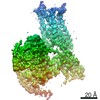 9912MC  9911C 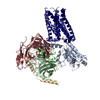 6k41C C: citing same article ( M: map data used to model this data |
|---|---|
| Similar structure data |
- Links
Links
- Assembly
Assembly
| Deposited unit | 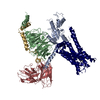
|
|---|---|
| 1 |
|
- Components
Components
-Guanine nucleotide-binding protein ... , 3 types, 3 molecules ABG
| #1: Protein | Mass: 40415.031 Da / Num. of mol.: 1 Source method: isolated from a genetically manipulated source Source: (gene. exp.)   Spodoptera (butterflies/moths) / References: UniProt: P63097 Spodoptera (butterflies/moths) / References: UniProt: P63097 |
|---|---|
| #2: Protein | Mass: 38530.992 Da / Num. of mol.: 1 Source method: isolated from a genetically manipulated source Source: (gene. exp.)   Spodoptera (butterflies/moths) / References: UniProt: P62874 Spodoptera (butterflies/moths) / References: UniProt: P62874 |
| #3: Protein | Mass: 7861.143 Da / Num. of mol.: 1 Source method: isolated from a genetically manipulated source Source: (gene. exp.)  Homo sapiens (human) / Gene: GNG2 / Production host: Homo sapiens (human) / Gene: GNG2 / Production host:  Spodoptera (butterflies/moths) / References: UniProt: P59768 Spodoptera (butterflies/moths) / References: UniProt: P59768 |
-Protein / Antibody / Non-polymers , 3 types, 3 molecules RH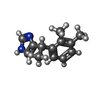

| #4: Protein | Mass: 58156.211 Da / Num. of mol.: 1 Source method: isolated from a genetically manipulated source Source: (gene. exp.)  Homo sapiens (human), (gene. exp.) Homo sapiens (human), (gene. exp.)  Enterobacteria phage RB59 (virus) Enterobacteria phage RB59 (virus)Gene: ADRA2A, ADRA2R, ADRAR, e, RB59_126, ADRA2B, ADRA2L1, ADRA2RL1 Production host:  Spodoptera (butterflies/moths) Spodoptera (butterflies/moths)References: UniProt: P08913, UniProt: A0A097J809, UniProt: P18089, lysozyme |
|---|---|
| #5: Antibody | Mass: 32898.781 Da / Num. of mol.: 1 Source method: isolated from a genetically manipulated source Source: (gene. exp.)   Spodoptera (butterflies/moths) Spodoptera (butterflies/moths) |
| #6: Chemical | ChemComp-CZX / |
-Details
| Has ligand of interest | Y |
|---|---|
| Has protein modification | Y |
-Experimental details
-Experiment
| Experiment | Method: ELECTRON MICROSCOPY |
|---|---|
| EM experiment | Aggregation state: 3D ARRAY / 3D reconstruction method: single particle reconstruction |
- Sample preparation
Sample preparation
| Component | Name: alpha2BAR-Gi1 complex / Type: COMPLEX / Entity ID: #1-#5 / Source: MULTIPLE SOURCES |
|---|---|
| Molecular weight | Value: 0.15 MDa / Experimental value: YES |
| Source (natural) | Organism:  Spodoptera (butterflies/moths) Spodoptera (butterflies/moths) |
| Buffer solution | pH: 7.5 |
| Specimen | Conc.: 10 mg/ml / Embedding applied: NO / Shadowing applied: NO / Staining applied: NO / Vitrification applied: YES |
| Specimen support | Grid material: GOLD / Grid mesh size: 400 divisions/in. / Grid type: Quantifoil R1.2/1.3 |
| Vitrification | Instrument: FEI VITROBOT MARK IV / Cryogen name: ETHANE / Humidity: 100 % |
- Electron microscopy imaging
Electron microscopy imaging
| Experimental equipment |  Model: Titan Krios / Image courtesy: FEI Company |
|---|---|
| Microscopy | Model: FEI TITAN KRIOS |
| Electron gun | Electron source:  FIELD EMISSION GUN / Accelerating voltage: 300 kV / Illumination mode: SPOT SCAN FIELD EMISSION GUN / Accelerating voltage: 300 kV / Illumination mode: SPOT SCAN |
| Electron lens | Mode: BRIGHT FIELD |
| Image recording | Electron dose: 50 e/Å2 / Detector mode: SUPER-RESOLUTION / Film or detector model: GATAN K2 SUMMIT (4k x 4k) |
- Processing
Processing
| Software | Name: PHENIX / Version: 1.13_2998: / Classification: refinement |
|---|---|
| EM software | Name: PHENIX / Category: model refinement |
| CTF correction | Type: NONE |
| 3D reconstruction | Resolution: 4.1 Å / Resolution method: FSC 0.143 CUT-OFF / Num. of particles: 235982 / Symmetry type: POINT |
 Movie
Movie Controller
Controller



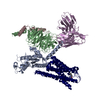
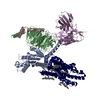
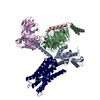
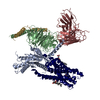



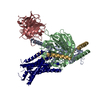

 PDBj
PDBj
























